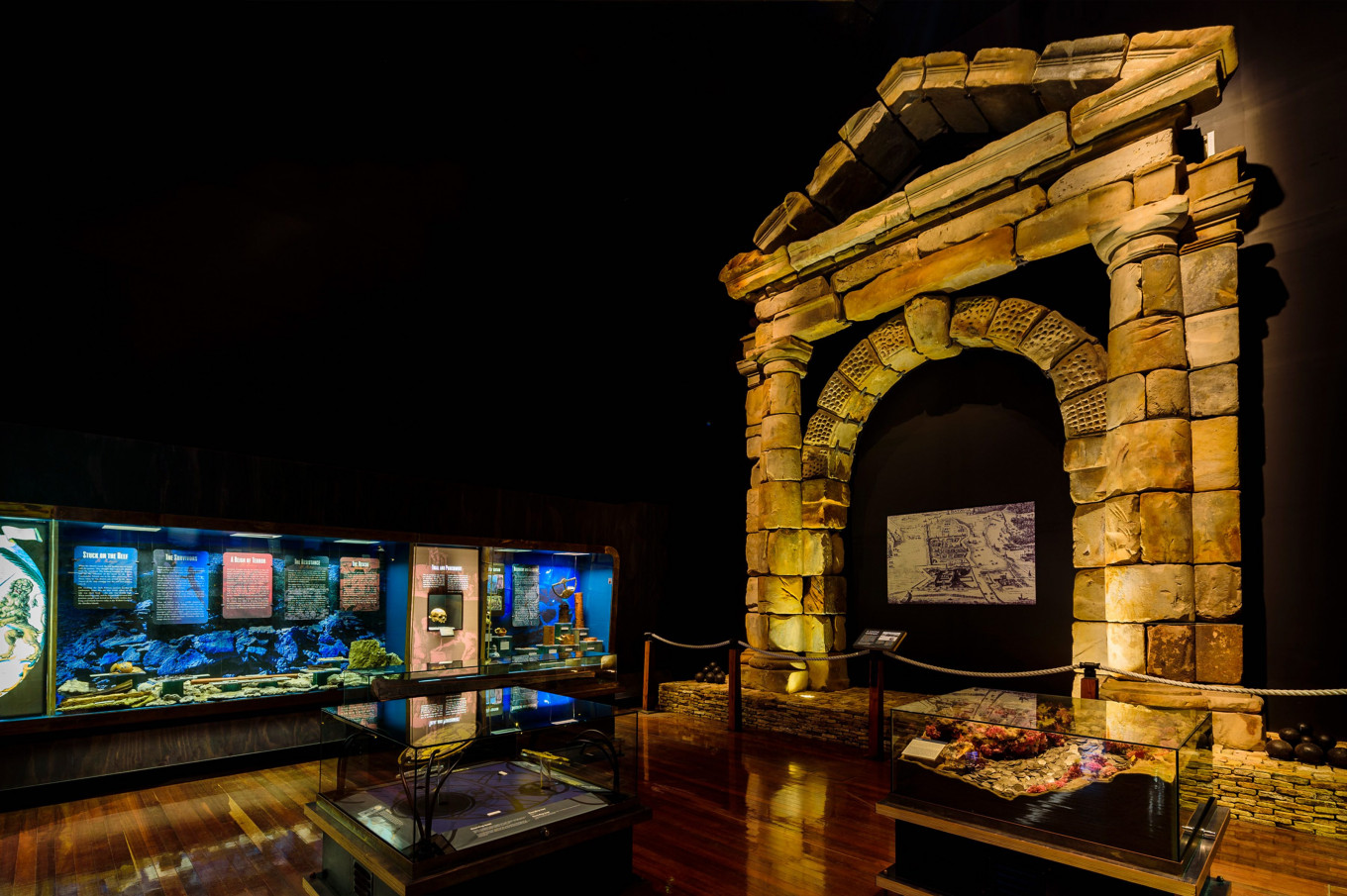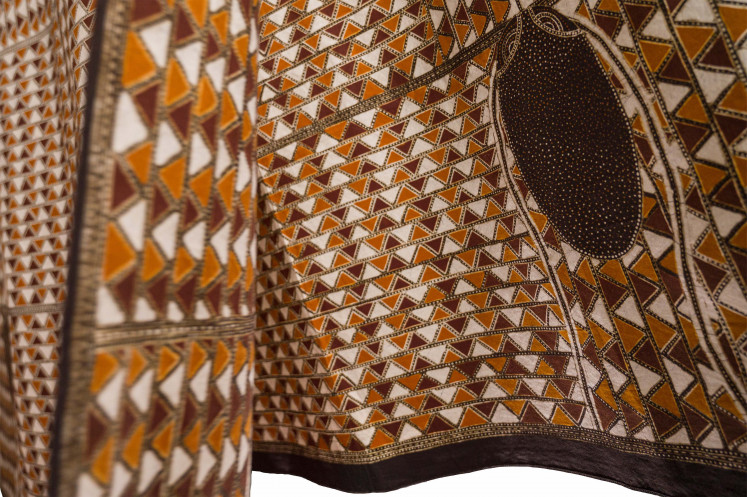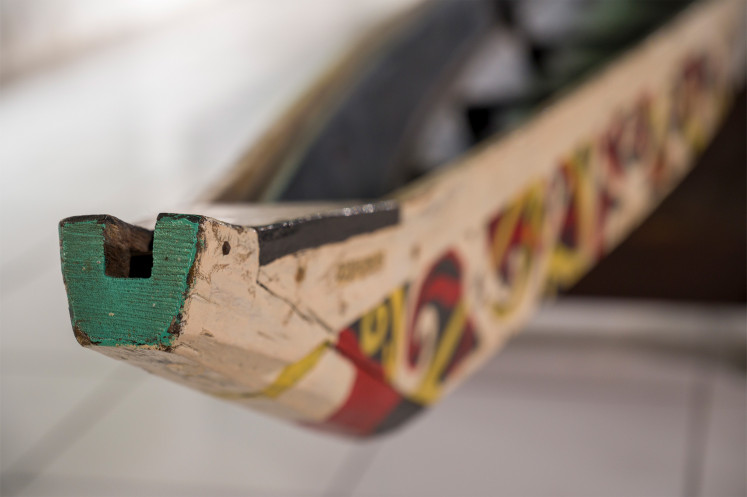Popular Reads
Top Results
Can't find what you're looking for?
View all search resultsPopular Reads
Top Results
Can't find what you're looking for?
View all search resultsTracing Indonesian-Australian ties through historical objects
Change text size
Gift Premium Articles
to Anyone
A
joint Indonesian-Australian exhibition uses historical objects to rethink the ties and connections between the two countries, as well as their colonial histories.
The intricate, earth-colored patterns on the cloth looked like the motifs of Australia’s indigenous Aborigine people. Displayed in the Jakarta Textile Museum, the white-and-reddish-orange symmetrical triangles typically take the shape of crocodiles, kangaroos or rainbow serpents in their dreamtime traditional beliefs and mythology.
While the work evoked the Australian outback, its title Yirrkala Batik showed an Indonesian influence.
“The Yirrkala Batik is an interpretation of bark paintings made by [Australian Aboriginal artist] Ronald Nawurapu Wunungmurra […] which tell the story of Makassar [Bugis] sailors who visited Arnhem Land [in Northern Australia],” said Jakarta Textile Museum curator Ardi Hariyadi of the 2 meters by 1 m work.
The work was created by the Yirrkala Arts Center in Arnhem Land and the Galeri Buana Alit batik manufacturer from the city of Pekalongan, Central Java. He added that the Yirrkala Batik’s triangular-shaped motifs represented the sails of a Bugis ship sailing to Arnhem Land.
“Since ancient times the Bugis people […] sailed to northeastern Australia in search of sea cucumbers and interacted with indigenous Australians,” Ardi asserted.
He added that Yirrkala Batik, which was a gift from the Australian Embassy in Jakarta to the Jakarta Textile Museum in 2015, and other artifacts, reflected the Bugis’ age-old maritime proficiency.
Ruling the waves: A detail from the Yirrkala Batik recalls the impressions Bugis seafarers made on the Aborigines of northern Australia. (Courtesy of AIM Project) (Courtesy of AIM Project/Courtesy of AIM Project)Rediscover and reinterpret history
As an artistic collaboration between Indonesia and Australia, Yirrkala Batik is one of the exhibits featured in Tetangga: People, Places and Objects, a joint online exhibition held by the Australian and Indonesian governments.
Derived from the Indonesian term tetangga which means “neighbor”, the exhibition is part of the Australia-Indonesia Museums (AIM) Project, a joint initiative between the Department of Foreign Affairs and Trade (DFAT) and the Indonesian Education, Culture, Research and Technology Ministry, under the hub of the Australia-Indonesia Institute (AII).
In its press release, AIM said more than 80 Australian and Indonesian curators, historians and academics from such institutions as Deakin University's Cultural Heritage and Museums Studies program, Museum Nasional Indonesia, the Western Australian Museum (WAM) and 14 partner museums from across Indonesia contributed to the Tetangga exhibition, which aims to reevaluate Australian and Indonesian history.
“[Tetangga] is part of the ongoing challenge to the legacies of colonialism [in Australia and Indonesia] […] Museum curators in Australia and Indonesia, together, have creatively reexamined the interpretation of museum objects,” the AIM Project said in a press release.
Deakin University associate Professor of Cultural Heritage and Museum Studies Steven Cooke reiterated AIM’s goals.
“Traditionally, [museum] exhibitions have been developed through a national frame-of-reference, but more recent approaches are exploring transnational connections of people, objects and ideas,” he said during the Tetangga exhibition’s online launch on June 17.
“[The AIM Project] has developed new approaches to understanding how these histories are collected, displayed and interpreted in Australian and Indonesian museums.”
Unearthing past links: Archeologists from the Western Australia Museum dig up artifacts left by Indonesian fishermen in Western Australia. (Courtesy of AIM Project) (Courtesy of AIM Project/Courtesy of AIM Project)Finding historical links
Most of all, AIM Project’s primary goal for Tetangga is to touch on “any objects and stories [that] illustrate the historic and contemporary connections and flows of people, ideas and objects between Australia and Indonesia”.
Similar to Yirrkala Batik, these include archeological artifacts related to the Buginese mariners who inspired the work.
“Ceramic shards and metal artifacts [including a fish hook and lead musket ball] found at fishing camps in northern Western Australia show the movement of Indonesian[s] including Makassan seasonal fishers across the region. This archeological collection comes from Tamarinda, Low Island and Klembei [from] the Kimberley [region],” said the AIM Project of the innocuous-looking artifacts left by Makassan or Makassar fishermen from Indonesia’s South Sulawesi province.
Archeologists from Western Australian Museum and the University of Western Australia have excavated the site since the 1960s. Their findings “revealed hearths and smokehouses possibly for the preparation of trepang [sea cucumber, thelenota ananas]. Based in part on an 1823 Dutch coin, the camp was dated between 1825-1850.”
The artifacts included earthenware and Chinese porcelain, as well as “cooking pots brought to Napier Broome Bay onboard Asian boats or praus [that] have been reconstructed from ceramic shards found or excavated on shore. Mineral analysis of the clay has revealed Foraminifera fossils [marine species] and silicate, suggesting these vessels were made in island Southeast Asia from coastal and beach sediments.”
The Yeidji or Kwini Balanggara aboriginal people of Western Australia helped out with the dig and reconnected with the Museum’s artifacts as they did so.
A glimpse of colonial Batavia
The massive portico stood high in the Western Australian Museum, its weathered stonework comparable to the ancient ruins of the Roman Forum or the Pergamon Altar in Berlin. Dated to the 17th century, the structure provided a glimpse of the Dutch’s large-scale-building projects in their colonies in present-day Indonesia.
“This portico […] was recreated from 137 sandstone blocks recovered from the wreck of the [Dutch East India Company ship] Batavia by maritime archeologists with the Western Australian Museum. [The find] is extant physical evidence of the design of Kasteel Batavia [Batavia Castle],” Western Australian Museum curator Corioli Souter noted, referring to the fortification the Dutch built to protect Batavia.
She added that 17th-century Dutch drawings, journals and other entries backed this premise. Souter also noted that the stones were as versatile as they were decorative. “Weighing 37 tons, the blocks were used to ballast the outward-bound Verenigde Oostindische Compagnie (VOC) or Dutch East India Company ship.”
The stones, which came from the northwest German town of Bentheim near the border with the Netherlands, is also a popular building material for the Dutch, who used it for their town halls, castles and other secular structures.
Then-governor-general Herman Willem Daendels demolished the structure and other parts of Oud Batavia or the Old Town in 1809. AIM Project noted that archeologists from the University of Indonesia excavated the site of Kasteel Batavia in 2021 on Jl Tongkol street in North Jakarta’s Pademangan area.
Rowing down the stream: The bow of a Dayak alut pasa or long boat boasts the same sleek lines and vivid colors that has been their trademark for years. (Courtesy of AIM Project) (Courtesy of AIM Project/Courtesy of AIM Project)Tracing a shared-maritime heritage
The aerodynamic, graceful lines of the Dayak alut pasa or long boat exhibited in the Jakarta Maritime Museum are as colorful as they are sleek. According to curator Nabila Khoirunnisa, the red, yellow, white and green tendrils on the alut pasa or sampan “represent tree branches and have symbolic meaning relating to kinship between communities”.
Made of ironwood, the ships are long known as one of Kalimantan’s ubiquitous sights, as the Dayak plied the vessels through the large rivers crisscrossing the island.
“In Dayak culture, the canoe is not just a means of transportation, but has wider cultural significance and is used in […] traditional ceremonies and rituals, including to welcome guests,” said museum curator Nabila Khoirunnisa.
“The shape of the alut pasa boat is similar to traditional [bark] canoes from Australia but are generally larger in size. They differ in that the alut pasa can accommodate up to 20 people”, in contrast to Australian vessels, which usually have a two-man crew.
However, she has yet to determine if the alut pasa influenced the techniques used in building Australian bark or dugout canoes.
Aside from the Yirrkala Batik, the portico and Dayak long boat, the Tetangga exhibition also featured the Si Jagur cannon, an iconic Portuguese 17th-century artillery piece manufactured in Macau and captured by the Dutch after the latter captured Malacca in 1641.
Now in the custody of the Jakarta History Museum, the piece went from a symbol of conquest to a symbol of fertility, not least because it featured an obscene gesture.
Other objects continue to be tangible mementos of colonialism, such as an Acehnese coffee grinder and rare copies of Dutch-colonial-official Edward Douwes Dekker’s novel Max Havelaar, which he wrote under the pseudonym Multatuli.
The former symbolized the Acehnese people’s determination to enjoy robusta and arabica coffee grown in their area, in defiance of a Dutch monopoly on the commodity, which was one of their most-lucrative exports.
But whether these, or the dozens if not hundreds of items in this online exhibition will catch your eye, remains to be seen. What is for certain is that these historical objects might just prove to be worthwhile food for thought.
Tetangga exhibition is available until June 17, 2023.
Website: tetanggaexhibition.com














